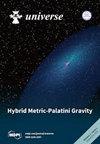利用龙虾眼天文成像仪对室女座星团进行宽视场 X 射线观测的研究
IF 2.5
4区 物理与天体物理
Q2 ASTRONOMY & ASTROPHYSICS
引用次数: 0
摘要
龙虾眼天文成像仪(LEIA)是爱因斯坦探测器任务中使用的宽视场X射线望远镜的探路者。在这项研究中,我们展示了一幅室女座星团的图像,该图像是由LEIA在0.5-4.5 keV波段拍摄的,中心区域的曝光时间为17.3 ks。这种延伸发射与 ROSAT 卫星获得的结果基本一致。然而,由于仪器的点展宽函数(PSF)效应,该场受到明亮点源的影响。通过拟合室女座星团的 LEIA 光谱,我们得到了 2.1-0.1+0.3 keV 的温度,这与 XMM-Newton 的结果(∼2.3 keV)一致。在 1.6 keV 以上,光谱被 X 射线背景所主导。总之,这项研究首次验证了 LEIA 的扩展源成像和光谱分辨率能力。本文章由计算机程序翻译,如有差异,请以英文原文为准。
Study of Wide-Field-of-View X-ray Observations of the Virgo Cluster Using the Lobster Eye Imager for Astronomy
The Lobster Eye Imager for Astronomy (LEIA) is the pathfinder of the wide-field X-ray telescope used in the Einstein Probe mission. In this study, we present an image of the Virgo Cluster taken by LEIA in the 0.5–4.5 keV band with an exposure time of ∼17.3 ks in the central region. This extended emission is generally consistent with the results obtained by ROSAT. However, the field is affected by bright point sources due to the instrument’s Point Spread Function (PSF) effect. Through fitting of the LEIA spectrum of the Virgo Cluster, we obtained a temperature of 2.1−0.1+0.3 keV, which is consistent with the XMM-Newton results (∼2.3 keV). Above 1.6 keV, the spectrum is dominated by the X-ray background. In summary, this study validates LEIA’s extended source imaging and spectral resolution capabilities for the first time.
求助全文
通过发布文献求助,成功后即可免费获取论文全文。
去求助
来源期刊

Universe
Physics and Astronomy-General Physics and Astronomy
CiteScore
4.30
自引率
17.20%
发文量
562
审稿时长
24.38 days
期刊介绍:
Universe (ISSN 2218-1997) is an international peer-reviewed open access journal focused on fundamental principles in physics. It publishes reviews, research papers, communications, conference reports and short notes. Our aim is to encourage scientists to publish their research results in as much detail as possible. There is no restriction on the length of the papers.
 求助内容:
求助内容: 应助结果提醒方式:
应助结果提醒方式:


